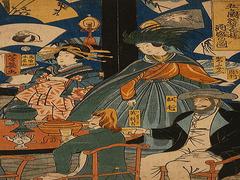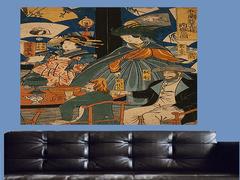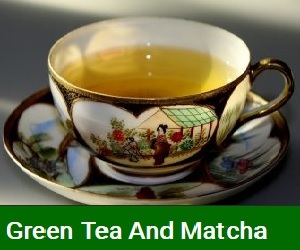The Edo period (1603-1868) in Japan witnessed a remarkable transformation of society and culture. A unique art form emerged during this time, known as ukiyo-e or woodblock prints, which provided a vivid snapshot of everyday life, aspirations, and societal shifts. This article delves into the world of Edo period woodblock prints, exploring how they served as a societal mirror, capturing the nuances of a rapidly changing society.
The Edo Period: Urban Culture and Flourishing Art
The Edo period marked a time of relative peace and prosperity in Japan. Urban centers like Edo (now Tokyo) grew rapidly, leading to the development of a vibrant urban culture. This period saw the rise of a new merchant class and a newfound focus on leisure, entertainment, and aesthetics. Woodblock prints emerged as a medium that catered to the tastes and interests of this burgeoning urban society.
Visual Chronicles of Urban Life
Woodblock prints provided a window into the bustling urban life of Edo. Artists depicted scenes of markets, teahouses, kabuki theaters, and courtesans, offering viewers a glimpse into the vibrant world of entertainment, fashion, and leisure activities. These prints often captured the transient nature of city life, reminding the audience of the fleeting moments that make up existence.
The Floating World: Kabuki and Courtesans
Two prominent subjects in Edo period woodblock prints were kabuki actors and courtesans. Kabuki theater, a form of stylized drama, was immensely popular, and prints featuring famous actors allowed fans to connect with their idols offstage. Courtesans, on the other hand, represented both beauty and danger, offering an alluring yet often unattainable ideal of femininity.
Social Commentary and Satire
Woodblock prints weren't limited to celebratory depictions; they also served as a means of social commentary and satire. Some prints highlighted the contrast between the luxurious lives of the courtesans and the struggles of commoners. Others portrayed humorous or satirical scenes that commented on societal norms, providing a unique perspective on the challenges and ironies of daily life.
Seasonal Imagery and Symbolism
Seasonal imagery played a significant role in woodblock prints, connecting nature to the urban environment. Prints depicting the changing seasons showcased the cultural importance of seasonal transitions, while symbolic elements often carried deeper meanings. Cherry blossoms represented transience, while pine trees symbolized longevity, allowing viewers to reflect on the impermanence and cyclical nature of life.
A Visual Record of Change
The Edo period saw shifts in gender roles, fashion trends, and social dynamics. Woodblock prints captured these changes, chronicling the evolution of society over time. From the emergence of new fashion styles to the portrayal of women as independent and fashionable figures, these prints acted as a visual record of societal transformation.
Enduring Legacy and Influence
Edo period woodblock prints continue to captivate modern audiences and influence contemporary art forms. Their ability to depict everyday life with both accuracy and artistry speaks to the universal human experience. As repositories of historical and cultural information, these prints provide a lens through which we can explore the world of Edo and the intricate interplay between tradition and modernity.
Conclusion
Edo period woodblock prints transcend mere artistic expression; they are a reflection of an era, capturing its vibrancy, complexity, and dynamism. By immortalizing the minutiae of daily life, these prints provide us with a unique vantage point from which to appreciate the profound cultural and societal shifts that took place in Edo Japan. As we gaze upon these prints, we step into the past, connecting with a world that has left an indelible imprint on our collective understanding of history and humanity.
- Beyond Ukiyo-e: The Diverse Landscape of Japanese Woodblock Art
- Evolution of Japanese Woodblock Printing: Tracing the Roots of an Artistic Tradition
- From Edo to the World: How Japanese Woodblock Prints Shaped Western Art and Culture
- Japanese Woodblock History
- Masters of the Blade and Block: The Collaborative Artistry of Samurai and Woodblock Printmakers
- Resilience and Reinvention: Japanese Woodblock Printing in the Face of Modernization
- Techniques and Traditions: Unraveling the Intricacies of Japanese Woodblock Printmaking
- The Influence of Nature in Japanese Woodblock Prints: Depicting Seasons and Symbolism
- The Societal Mirror: Reflecting Daily Life in Edo Period Woodblock Prints
- The Woodblock Artisans of Edo: Masters of Craftsmanship and Creativity
- Ukiyo-e Renaissance: Exploring the Golden Age of Japanese Woodblock Prints




